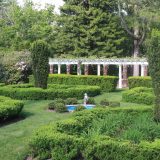Background
While Charles Sprague Sargent, founding director of the Arnold Arboretum in Boston, Massachusetts, is a well-known figure in American horticultural history, the network of gardening elites and horticultural professions he nurtured has received little attention.
Networking was fundamental to the creation of gardens in the northeast at the turn of the 20th century. Reciprocal benefits bound regional gardeners together. Sargent’s web of associates included, in particular, George Rogers Hall of Bristol, Rhode Island, the first American to import Japanese plants to the United States. Prominent nurseries, such as Parsons & Sons, of Flushing, New York, as well as influential collectors including H.H. Hunnewell of Wellesley, Massachusetts, were members of the cultivated circle. Examining their interactions offers the opportunity to follow for the first time the diffusion of the new Japanese botanicals and thereby to trace the physical transformation of American gardens in the 19th century.
Dissemination of exotics also went hand in hand with that of aesthetics. Hall was more than a pivotal importer; his work also shaped the design of the modern arboretum. Sargent and others who visited Hall’s Bristol garden marveled at the “great evergreen border,” his compact plantation reminiscent of a small forest of Japanese trees. The picturesque planting of a scientific collection resonated with Sargent’s planning of the arboretum in Boston. While Frederick Law Olmsted’s participation in the layout are well documented, this talk will show that Hall’s gardening constituted an overlooked influence on the design of the country’s first public arboretum. Guided by Sargent and bound together loosely by threads of common interest, Hall and others contributed to building a scientific institution as they also crafted pleasure gardens in the orbit of the Arnold Arboretum.


